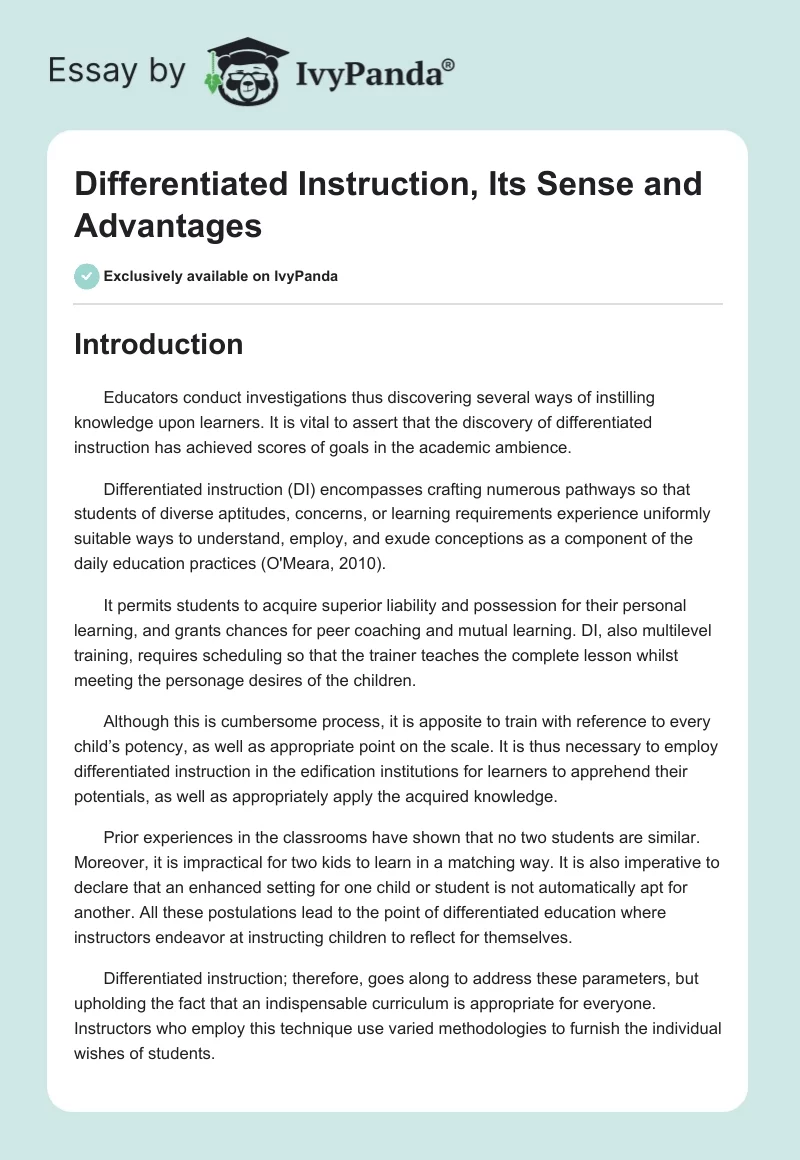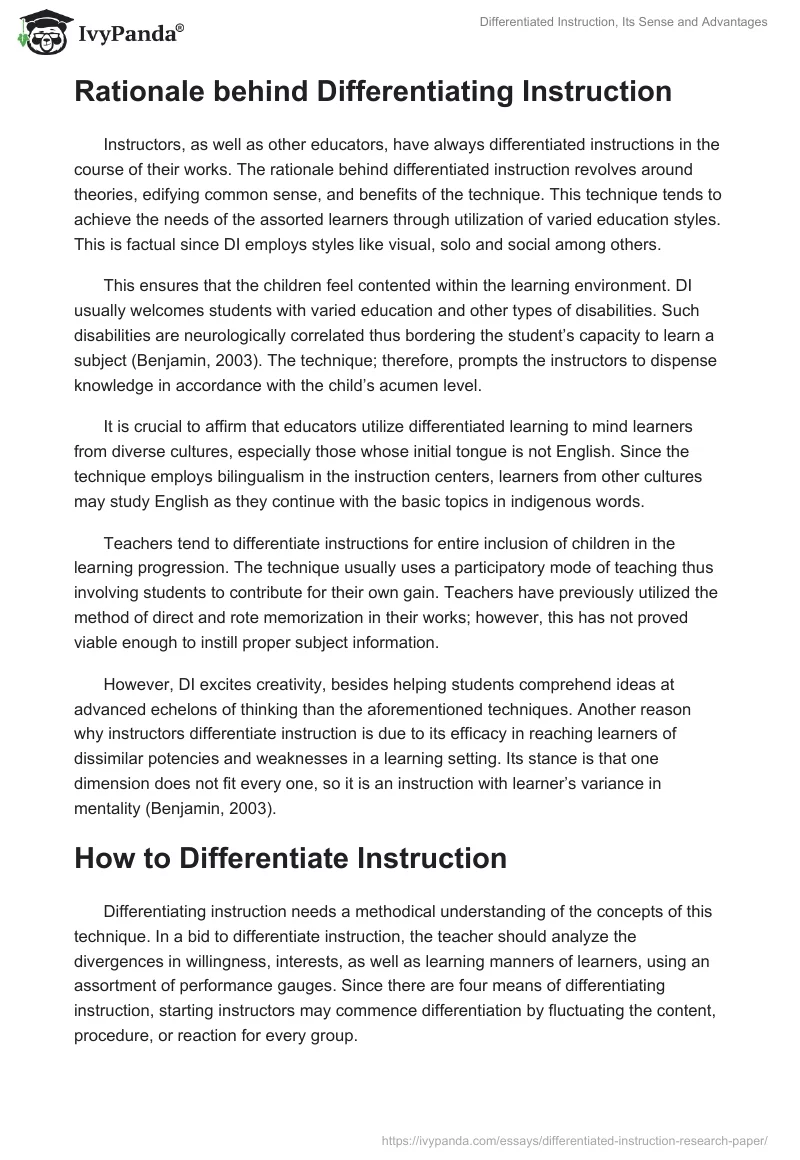Introduction
Educators conduct investigations thus discovering several ways of instilling knowledge upon learners. It is vital to assert that the discovery of differentiated instruction has achieved scores of goals in the academic ambience.
Differentiated instruction (DI) encompasses crafting numerous pathways so that students of diverse aptitudes, concerns, or learning requirements experience uniformly suitable ways to understand, employ, and exude conceptions as a component of the daily education practices (O’Meara, 2010).
It permits students to acquire superior liability and possession for their personal learning, and grants chances for peer coaching and mutual learning. DI, also multilevel training, requires scheduling so that the trainer teaches the complete lesson whilst meeting the personage desires of the children.
Although this is cumbersome process, it is apposite to train with reference to every child’s potency, as well as appropriate point on the scale. It is thus necessary to employ differentiated instruction in the edification institutions for learners to apprehend their potentials, as well as appropriately apply the acquired knowledge.
Prior experiences in the classrooms have shown that no two students are similar. Moreover, it is impractical for two kids to learn in a matching way. It is also imperative to declare that an enhanced setting for one child or student is not automatically apt for another. All these postulations lead to the point of differentiated education where instructors endeavor at instructing children to reflect for themselves.
Differentiated instruction; therefore, goes along to address these parameters, but upholding the fact that an indispensable curriculum is appropriate for everyone. Instructors who employ this technique use varied methodologies to furnish the individual wishes of students.
Rationale behind Differentiating Instruction
Instructors, as well as other educators, have always differentiated instructions in the course of their works. The rationale behind differentiated instruction revolves around theories, edifying common sense, and benefits of the technique. This technique tends to achieve the needs of the assorted learners through utilization of varied education styles. This is factual since DI employs styles like visual, solo and social among others.
This ensures that the children feel contented within the learning environment. DI usually welcomes students with varied education and other types of disabilities. Such disabilities are neurologically correlated thus bordering the student’s capacity to learn a subject (Benjamin, 2003). The technique; therefore, prompts the instructors to dispense knowledge in accordance with the child’s acumen level.
It is crucial to affirm that educators utilize differentiated learning to mind learners from diverse cultures, especially those whose initial tongue is not English. Since the technique employs bilingualism in the instruction centers, learners from other cultures may study English as they continue with the basic topics in indigenous words.
Teachers tend to differentiate instructions for entire inclusion of children in the learning progression. The technique usually uses a participatory mode of teaching thus involving students to contribute for their own gain. Teachers have previously utilized the method of direct and rote memorization in their works; however, this has not proved viable enough to instill proper subject information.
However, DI excites creativity, besides helping students comprehend ideas at advanced echelons of thinking than the aforementioned techniques. Another reason why instructors differentiate instruction is due to its efficacy in reaching learners of dissimilar potencies and weaknesses in a learning setting. Its stance is that one dimension does not fit every one, so it is an instruction with learner’s variance in mentality (Benjamin, 2003).
How to Differentiate Instruction
Differentiating instruction needs a methodical understanding of the concepts of this technique. In a bid to differentiate instruction, the teacher should analyze the divergences in willingness, interests, as well as learning manners of learners, using an assortment of performance gauges. Since there are four means of differentiating instruction, starting instructors may commence differentiation by fluctuating the content, procedure, or reaction for every group.
As the educator gets expertise in technique, differentiation can happen at all three ranks of the course for various students. Differentiating content obliges a teacher to pre-analyze students who do not need express instruction. Content entails knowledge, talents, as well as feelings. Students signifying elevated understanding on the topic may pass over the lessons, but maintain on applying the conceptions to the assignment solving (O’Meara, 2010).
Teachers can also achieve this by differentiating process through changing the learning stratagems or activities to offer suitable methods for learners to discover the concepts. This offers the students substitute itineraries of maneuvering the ideas entrenched in the conception. For instance, students can utilize graphic controllers, atlas, illustrations, or chats to exhibit their understanding of the concepts learnt.
Another way is differentiating the result, where the teacher varies the intricacy of the product produced by the students to express the mastery of the ideas. This implies that a teacher would expect a further composite and sophisticated thinking from an above-rank learner, as opposed to students operating underneath the grade rank.
Finally, educators can differentiate instruction by stage-managing the environment, as well as accepting personage-studying styles. Individual students have varied learning modes; therefore, allowing them to exude such styles helps in mastery and application of the subjects.
Usage of Technology in a Diversified Population of Students
The use of technology is imperative in instilling knowledge, in a diversified population of students. However, the modes of application of such technologies greatly contribute to their success (Pitler, et al., 2007). There are plentiful ways that teachers can use a technology in a dissimilar population of students. One can use participatory smart boards in place of chalkboards in class teachings.
It is a flat monitor, which has a link with the teacher’s CPU, as well as school Internet. This allows students to participate in the disciplines like spelling, mathematics, among others. Additionally, the use of touch screen expertise proves viable since students can use remote clickers when responding to the query. It is noteworthy to combine technology with the traditional mode of teaching to make learning all-inclusive, engaging, and pleasurable.
A teacher should understand the formula for victory, which engages the student, content, as well as the surroundings in which he or she is applying the technology. Owing to the prevailing online books and other interactive actions, teachers can permit children to go online to complete the tasks. Consequently, one can provide the publisher’s website so that learners can complete the tasks at home.
Instructors can, as well offer options to the students on the best and familiar mode of technology to boost their learning. This implies that a diversified class may comprise a group, which is conversant with a technology, as opposed to another. There is a need to use a combination of technologies like computer games, videos, virtual museums, and interactive websites (Pitler, et al., 2007).
Conclusion
Although differentiated instruction is not a novel mode of teaching, it is gaining popularity due to its success. Educators should have a substantial idea in DI to implement it effectively in the classrooms. There is assorted basis for differentiating instructions, and these are based on investigation, common sense, and advantages. One can differentiate instruction by changing content, procedure, setting, and result.
Educators can always implement these slowly as they gain momentum in this technique. The use of technology to ensure excellent learning in a diverse populace of students requires a thorough understanding of the technology, as well as combining it with the traditional instructional methods.
References
Benjamin, A. (2003). Differentiated instruction: a guide for elementary school teachers. New York, NY: Eye on Education.
O’Meara, J. (2010). Beyond Differentiated Instruction. California, CA: Corwin Press.
Pitler, H., Hubbell, E. Kuhn, M. & Malenoski, (2007). Using technology with classroom instruction that works. Virginia, VA: ASCD.


